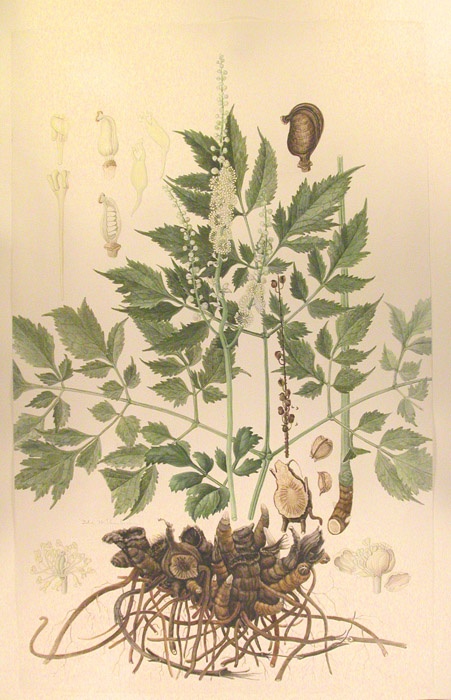 MATERIA MEDICA: BLACK COHOSH
MATERIA MEDICA: BLACK COHOSH
This well-known herb goes above and beyond it’s commonly understood uses, from women’s issues, to depression, to muscle aches, it’s versatility makes it shine.
Latin Name: Actaea racemosa (formerly Cimicifuga racemosa)
Plant Family: Ranunculaceae (Buttercup Family)
Parts Used: rhizome, root
Description & Growing
Black cohosh is a perennial that can reach 8 feet in height. The smooth, furrowed stem divides into thirds and the leaves are tripinnately compound with a serrated margin. The flowers appear on tall racemes, and have no petals. The rhizome is dark and knotty (Grieve, 1931/1971; Soule, n.d.) It can be found in Eastern North America from Georgia to Ontario and Quebec, and from Missouri and Arkansas through the Appalachians, Pennsylvania, New York, Massachusetts. Black cohosh is listed as endangered in Massachusetts and Illinois, and is on the United Plant Savers' "At Risk" list. Only organically cultivated black cohosh should be used. Please do not harvest wild black cohosh. Reminder: do not harvest from wild. Cultivated black cohosh root may be harvested in the fall after the aerial parts have died down Key Constituents: Triterpene glycosides, isoferulic acid, salicylic acid, tannins, resins, phytosterols, fatty acids, starch (Blumenthal, 2003). Preparation & Dosing- Decoction: .5 - 1 teaspoon dried root simmered in 1 cup water for 10-15 minutes.
- Tincture: 2 - 4 mL, 1:5 in 60%, three times/day.
- Dosage information from Medical Herbalism by David Hoffman
Energetics: bitter, pungent, cool, dry
Actions

- Alterative
- Analgesic
- Anti-inflammatory
- Antispasmodic
- Emmenagogue
- Anti-rheumatic
- Diaphoretic
- CNS depressant
- Muscle relaxant
- Sedative
Uses
- For a great detailed monograph on Black Cohosh check out the Herbarium
- Anxiety (related to menopause)
- Aphrodisiac
- Arthritis
- Asthma
- Breast Cysts
- Bronchitis
- Colitis
- Convulsions
- Debility
- Depression
- Dysmenorrhea
- Dyspareunia (painful sexual intercourse)
- Flu associated aches & pains: https://avivaromm.com/how-7-top-herbalists-and-doctors-fight-the-flu
- Headache
- Heart Palpitations
- Hot flashes: https://avivaromm.com/help-in-a-flash-herbs-and-foods-for-common-menopausal-symptoms
- Hyperhidrosis (excessive sweating)
- Improve Circulation
- Insomnia
- Irritability
- Lowers Blood Pressure
- Mastitis
- Menopause Symptoms (including hot flashes)
- Mood Swings
- Night Sweats: https://avivaromm.com/herbal-remedies-hot-flashes-night-sweats
- Premenstrual Syndrome: https://avivaromm.com/pms
- Rheumatism
- Sciatica
- Support healthy menses
- Tinnitus
- Tuberculosis
- Vaginal atrophy
- Vaginal dryness
- Vertigo
- Whooping Cough
Safety
- Avoid during pregnancy and while nursing. Avoid with any heart conditions. Excess use may cause nausea, vomiting, headache, and lower blood pressure.
- Unlike pharmaceutical hormone replacement therapy, black cohosh is considered to be a menopause tonic that is safe for women with estrogen-dependent cancers, uterine bleeding, fibrocystic breast disease, endometriosis, liver disease, gallbladder disease, or pancreatitis.
- One report implicated black cohosh in a case of liver failure (Nisbet and O'Connor, 2007) but it wasn't clear if the problem stemmed from contamination or accidental substitution. Other studies suggest that black cohosh is safe if taken for a limited period (Huntley, 2004) and a systematic review of adverse events suggests that black cohosh is safe (Borrelli and Ernst, 2008). Blumenthal (2003) summarizes other findings suggesting some GI tract discomfort and if overdosed, symptoms like dizziness, headache, impaired vision and circulation may occur. Black cohosh should not be given to children.
References
- Beer AM, Osmers R, Schnitker J, Bai W, Mueck AO, Meden H. (2013). Efficacy of black cohosh (Cimicifuga racemosa) medicines for treatment of menopausal symptoms - comments on major statements of the Cochrane Collaboration report 2012 "black cohosh (Cimicifuga spp.) for menopausal symptoms (review)." Gynecol Endocrinol. Dec;29(12):1022-5.
- Blumenthal, Mark. (Ed.). (2003). The ABC Clinical Guide to Herbs. Austin, TX: American Botanical Council
- Borrelli F, Ernst E. (2008). Black cohosh (Cimicifuga racemosa): a systematic review of adverse events. Am J Obstet Gynecol. Nov;199(5):455-66.
- Burdette JE, Liu J, Chen SN, Fabricant DS, Piersen CE, Barker EL, Pezzuto JM, Mesecar A, Van Breemen RB, Farnsworth NR, Bolton JL. (2003). Black cohosh acts as a mixed competitive ligand and partial agonist of the serotonin receptor. J Agric Food Chem. Sep 10;51(19):5661-70.
- Ellingwood, Finley. (1919). Cimifuga. Cimifuga racemosa. The American Materia Medica. Retrieved October 2014 from http://www.henriettes-herb.com/eclectic/ellingwood/cimicifuga.html
- Felter, Harvey Wickes. (1922). Macrotys (Cimicifuga racemosa). The Eclectic Materia Medica, Pharmacology and Therapeutics. Retrieved October 2014 from http://www.henriettes-herb.com/eclectic/felter/cimicifuga.html
- Foster, Steven. (1999). Black Cohosh: A Literature Review. HerbalGram 45: 35-49.
- German Commission E. (1989). Black Cohosh. Retrieved October 2014 from cms.herbalgram.org/commissione/Monographs/Monograph0024.html
- Gladstar, Rosemary. (1993). Herbal Healing for Women. New York, NY: Fireside Books
- Hardin, Kiva Rose. (2007). A Few Herbs for Headaches. Retrieved October 2014 from http://bearmedicineherbals.com/a-few-herbs-for-headaches.html
- Herbarium Monographs
- Hoffman, David. (2003). Medical Herbalism. Rochester, VT: Healing Arts Press
- Huntley A. (2004). The safety of black cohosh (Actaea racemosa, Cimicifuga racemosa). Expert Opin Drug Saf. Nov;3(6):615-23.
- Johnson TL, Fahey JW. (2012). Black cohosh: coming full circle? J Ethnopharmacol. Jun 14;141(3):775-9.
- Leach MJ, Moore V. (2012). Black cohosh (Cimicifuga spp.) for menopausal symptoms. Cochrane Database Syst Rev. Sep 12;9:CD007244.
- McDonald, jim. (n.d.). “herbs for back pain.” Retrieved October 2014 from www.herbcraft.org/backpain.html
- Mohammad-Alizadeh-Charandabi S, Shahnazi M, Nahaee J, Bayatipayan S. (2013). Efficacy of black cohosh (Cimicifuga racemosa L.) in treating early symptoms of menopause: a randomized clinical trial. Chin Med. Nov 1;8(1):20.
- Nisbet BC, O'Connor RE. (2007). Black cohosh-induced hepatitis. Del Med J. Nov;79(11):441-4.
- Soule, Deb. Black Cohosh. United Plant Savers. Retrieved October 2014 from http://www.unitedplantsavers.org/content.php/189-Black-Cohosh
- Weed, Susun. (1992). Menopausal Years: The Wise Woman Way. Woodstock, NY: Ash Tree Publishing
- Wood, Matthew. (2004). The Practice of Traditional Western Herbalism. Berkeley, CA: North Atlantic Books



